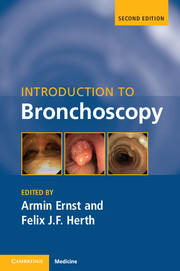96 results
Effect of Neutrophil to Lymphocyte ratio on antidepressant treatment response: moderating effect of sex and mediating effect of Hippocampal volumes.
-
- Journal:
- European Psychiatry / Volume 66 / Issue S1 / March 2023
- Published online by Cambridge University Press:
- 19 July 2023, p. S246
-
- Article
-
- You have access
- Open access
- Export citation
A review of the conservation status of Black Stork Ciconia nigra in South Africa, Lesotho, and Eswatini
-
- Journal:
- Bird Conservation International / Volume 33 / 2023
- Published online by Cambridge University Press:
- 11 April 2023, e56
-
- Article
-
- You have access
- Open access
- HTML
- Export citation
Index
-
- Book:
- Introduction to Bronchoscopy
- Published online:
- 21 July 2017
- Print publication:
- 07 September 2017, pp 191-199
-
- Chapter
- Export citation
Contents
-
- Book:
- Introduction to Bronchoscopy
- Published online:
- 21 July 2017
- Print publication:
- 07 September 2017, pp v-v
-
- Chapter
- Export citation
Copyright page
-
- Book:
- Introduction to Bronchoscopy
- Published online:
- 21 July 2017
- Print publication:
- 07 September 2017, pp iv-iv
-
- Chapter
- Export citation
Contributors
-
- Book:
- Introduction to Bronchoscopy
- Published online:
- 21 July 2017
- Print publication:
- 07 September 2017, pp vi-viii
-
- Chapter
- Export citation

Introduction to Bronchoscopy
-
- Published online:
- 21 July 2017
- Print publication:
- 07 September 2017
Diagnostic Conversion to Bipolar Disorder in Unipolar Depressed Patients Participating in Trials on Antidepressants
-
- Journal:
- European Psychiatry / Volume 40 / February 2017
- Published online by Cambridge University Press:
- 18 December 2016, pp. 76-81
-
- Article
- Export citation
“Colossal” Interstitial Supersaturation in Delta Ferrite in 17-7 PH Stainless Steels After Low-temperature Nitridation
-
- Journal:
- Microscopy and Microanalysis / Volume 22 / Issue S3 / July 2016
- Published online by Cambridge University Press:
- 25 July 2016, pp. 2020-2023
- Print publication:
- July 2016
-
- Article
-
- You have access
- Export citation
Contributors
-
-
- Book:
- The Cambridge Dictionary of Philosophy
- Published online:
- 05 August 2015
- Print publication:
- 27 April 2015, pp ix-xxx
-
- Chapter
- Export citation
Colossal Carbon Supersaturation of Delta Ferrite in 17-7 PH Stainless Steel
-
- Journal:
- Microscopy and Microanalysis / Volume 20 / Issue S3 / August 2014
- Published online by Cambridge University Press:
- 27 August 2014, pp. 2102-2103
- Print publication:
- August 2014
-
- Article
-
- You have access
- Export citation
Contributors
-
-
- Book:
- Money as God?
- Published online:
- 05 June 2014
- Print publication:
- 01 May 2014, pp x-xi
-
- Chapter
- Export citation
Contributors
-
-
- Book:
- Linking Global Trade and Human Rights
- Published online:
- 05 February 2014
- Print publication:
- 20 March 2014, pp ix-xii
-
- Chapter
- Export citation
Auger Electron Spectroscopy of Carbon Diffusion Profiles in Low Temperature Carburized Stainless Steels
-
- Journal:
- Microscopy and Microanalysis / Volume 19 / Issue S2 / August 2013
- Published online by Cambridge University Press:
- 09 October 2013, pp. 1106-1107
- Print publication:
- August 2013
-
- Article
-
- You have access
- Export citation
Apolipoprotein E epsilon 4 genotype and a physically active lifestyle in late life: analysis of gene–environment interaction for the risk of dementia and Alzheimer's disease dementia
-
- Journal:
- Psychological Medicine / Volume 44 / Issue 6 / April 2014
- Published online by Cambridge University Press:
- 24 July 2013, pp. 1319-1329
-
- Article
- Export citation
WORKING GROUP on ABUNDANCES IN RED-GIANTS
-
- Journal:
- Proceedings of the International Astronomical Union / Volume 7 / Issue T28A / December 2011
- Published online by Cambridge University Press:
- 04 April 2012, pp. 196-198
- Print publication:
- December 2011
-
- Article
-
- You have access
- Export citation
Microcharacterization of Tribo Layers on Al–Steel
-
- Journal:
- Microscopy and Microanalysis / Volume 16 / Issue S2 / July 2010
- Published online by Cambridge University Press:
- 01 August 2010, pp. 1560-1561
- Print publication:
- July 2010
-
- Article
-
- You have access
- Export citation
A Continuous-Flow Gas Chromatography 14C Accelerator Mass Spectrometry System
-
- Journal:
- Radiocarbon / Volume 52 / Issue 2 / 2010
- Published online by Cambridge University Press:
- 18 July 2016, pp. 295-300
- Print publication:
- 2010
-
- Article
-
- You have access
- Export citation
A time series analysis of the rabies control programme in Chile
-
- Journal:
- Epidemiology & Infection / Volume 103 / Issue 3 / December 1989
- Published online by Cambridge University Press:
- 15 May 2009, pp. 651-657
-
- Article
-
- You have access
- Export citation
On the Thermoelectric Potential of Inverse Clathrates
-
- Journal:
- MRS Online Proceedings Library Archive / Volume 1166 / 2009
- Published online by Cambridge University Press:
- 31 January 2011, 1166-N06-03
- Print publication:
- 2009
-
- Article
- Export citation



